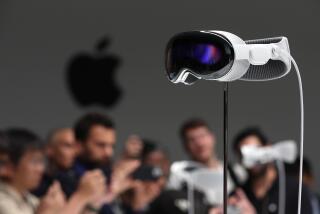EyeToy Springs From One Man’s Vision
- Share via
When Richard Marks laid eyes on a PlayStation 2, his first thought was: “Wouldn’t it be cool to add a camera?”
Nearly six years later, the device Marks imagined is one of Sony Corp.’s bestselling products: the $50 EyeToy, a tiny camera that enables video game players to control the action by jumping around and waving their arms while their images appear on-screen.
That EyeToy ever saw the light of day is remarkable, given that game makers are loath to risk adding expensive hardware to the stack of supposedly nifty peripherals that have flopped in the past.
“If there’s one thing that’s been hammered into my head over and over ... it’s that peripherals don’t sell, and the camera is a peripheral,” said Marks, 34, a Stanford avionics PhD who built cameras that guide one of the Monterey Bay Aquarium Research Institute’s underwater exploration robots.
In 1998, Marks didn’t know from video game peripherals. An independent technology consultant, he wandered through the noisy labyrinth of the Game Developers Conference in San Jose one day as a way to take his mind off work. As he watched a demonstration of the PlayStation 2, which was still two years from market, his idea about the camera took hold.
“I thought it was a fun thing to work on,” Marks said.
He mailed a pitch to Sony. The company called, invited Marks to visit and then offered him a job.
Marks, special projects manager for research and development, began tinkering in the Sony R&D; lab in Foster City, Calif., an engineer’s paradise.
The 25 programmers and engineers who work there don’t make games or develop products: They write chunks of computer code that help others at Sony make better games. Before EyeToy, the lab’s biggest hit was a program that makes assembly-programming language run faster on the PS2 console.
While working on other projects, Marks didn’t give up on his camera idea. He bought a Web camera and hooked it up to a computer that fed video to a PS2 prototype.
Then he tried building a game. His early efforts featured a crudely animated character he called Brickman that players could push around by waving their hands. “It was so bad, I’m not even allowed to show it,” Marks said.
Luckily for him, other game makers at Sony were better at graphics than he was. He borrowed some of their work and incorporated them into his project. One was a virtual pet that danced on a ball held by the player; the critter would careen with the ball’s movements, jump or fall off.
Next, Marks created a program that let players cast on-screen spells by moving their arms.
Every outside developer who saw Marks’ project liked it -- just not enough to take the risk of designing it for mass production, manufacturing it, building games around it and marketing it.
“I’d like to say that the idea was just so good that people couldn’t resist making it,” Marks said. “But I can’t.”
Despite its carefully managed image as an edgy industry, the $25-billion global video game business is fairly conservative. The cost of making and marketing games can run into the millions of dollars, and the memory of big failures sticks around.
Most people in the industry, for instance, either remember or have heard about the lengths Atari took in 1983 to rid itself of millions of unsold consoles and game cartridges. The company that essentially established the home video games business shipped several truckloads of merchandise straight from its production plant to a New Mexico landfill, where the stuff was crushed by steamrollers and covered with concrete.
Phil Harrison knew the legend. Harrison was Marks’ boss at the Sony lab, the designated business guy who kept the engineers in check. And he thought Marks was onto something with his camera when he saw it for the first time in 1999.
“I did back flips down the office,” said Harrison, who saw an opportunity to take PlayStation games to a wider audience. “For many people, the game controller is an intimidating device because it’s got these 14 buttons. With this, you didn’t need a controller. You could use your body to play.”
Making video games more accessible is like the Holy Grail for Sony, Microsoft Corp. and Nintendo Co., the three big makers of consoles.
Each new generation of consoles is heralded by its backers as the one to bring gaming to the masses. But, as Harrison noted, the way people interact with games has changed little from the days of “Pong.” For all the lush graphics and theatrical soundtracks, players still tap away at hand-held controllers and generally have to master button combinations that only a 13-year-old has time to learn.
So console makers are always looking for a technological and design breakthrough on the level of the computer mouse and graphical user interface, which made computers easy to operate for people who didn’t know the arcane text commands of DOS.
“We’re getting pretty close to the days of virtual reality,” said David Mercer, an analyst with Boston-based Strategy Analytics. “The technology is falling into place for you to be someone else in a different world.”
Sony’s Harrison believed Marks’ camera had potential, but it took a year before he was in a position to get it out of the lab. In fall 2000, as Sony launched the PlayStation 2 in North America, Harrison was promoted to head the European design studios.
Two weeks later, he summoned Marks to London, where he presented the camera to an audience of 450 game developers. His demonstration: popping bubbles on a computer screen with the wave of a wand.
After Marks was done, Harrison asked for a volunteer to build a game for the camera, and Ron Festejo took up the challenge.
A veteran Sony programmer, Festejo knew software the way Marks knew hardware. And, more important, he saw how a camera could change the way people used the PS2.
So in the summer of 2001, Marks moved his wife and three kids from Pleasanton, Calif., to London for three months to work with Festejo’s team. Sony would not reveal EyeToy’s development costs, except to say the budget was “significant” compared with the average $3 million to $5 million spent on a game.
The two men started with traditional video game concepts, where players would progress through many levels to finish a game. But those ideas required players who had experience with video games, not the novices they wanted to go after. So they cooked up a dozen simple mini-games that integrated a player’s movements into the action.
The EyeToy comes packaged with a disc of 12 such mini-games. In a game called “Kung Foo,” players whip their arms around to fight off attackers. With “Soccer Craze,” players use their bodies to keep a virtual ball from hitting the ground.
At Sony’s London office, the project was called iToy -- short for interactive toy. Then Harrison changed it to EyeToy. The name caught on with the marketing department, though not everyone saw its merits at first.
“When we showed an early version of the game to our marketing and sales force, you could see some of them wondering where this was going,” Harrison recalled. “When software is half done, it looks only 1% done. When it’s 80% done, it looks 2% done. You have to use your imagination to fill in the rest.”
By August 2002, Marks and Festejo were happy enough with their work to show it outside Sony. At a three-day Sony game event in London, thousands lined up to play.
“The line stretched across the convention center,” said Harrison. “And it wasn’t just gamers. It was also moms, dads and girlfriends who got dragged to the show. It was a pivotal point.”
The project’s developers had lucky timing. The PS2 had already been on the market for two years by 2002, and Sony was looking for a product that would jazz up the console and draw in mainstream players. EyeToy looked like a good fit.
Both Sony’s North American and Japanese PlayStation divisions, which make independent decisions on what to sell in their markets, picked up EyeToy. Sales projections grew from several hundred thousand units to several million.
By the end of 2003, it had sold more than 2 million units in Europe and 400,000 in the United States. Sony estimates it will have shipped 4 million units by March 31, the end of its fiscal year. Most titles are considered hits if they ship 500,000 units.
More EyeToy offerings are in the works, including a dancing game, due out this spring, in which players will move their arms in sync with music. The programming tools needed to write games for the EyeToy, available on Sony’s website, have been downloaded more than 1,000 times, giving Marks hope that his idea is being taken up by developers who may integrate it into future games.
“I hope EyeToy will go the route of the microphone and will just become part of the platform,” said Marks, sitting in his small office at the Foster City lab littered with bright Styrofoam cutouts, spray paint, duct tape and random toys stuffed in cupboards where files are supposed to be stored. “We’ve gotten better at displaying data, but we’re still not very good at finding ways for players to input data” such as voice and movement.
“In the future,” Marks said, “games might even recognize the color of your shirt, or whether you smile, and incorporate that into the game.”






